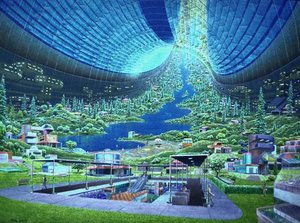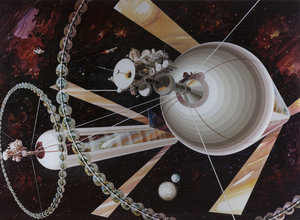Space habitats
 Main Page > Colonising Space > Space habitats
Main Page > Colonising Space > Space habitats
There are many suitable places to site a habitat in space, especially within the orbit of Jupiter. There have been many studies over the past thirty years to understand what kind of habitats could be built and what size constraints there are. Surprisingly the answer in the 1970s was that based on bridge and ship-building techniques it is possible to build orbiting megastructures up to 30 kilometers long, and a single one able to comfortably house millions of people.
Being mega-scale engineering projects, it is not hard to see that similar techniques could be used to make the interiors of these habitats be like beautiful places on Earth, like rolling green English countryside for example. Some designs even have enough atmosphere inside them to make the sky appear blue.
Contents
Places
Low Earth orbit
The easiest place to get to from Earth is low earth orbit, although due to the Earth's strong gravitational pull it requires enormous amounts of energy to bring material up from the surface and one could not be classed as self-sufficient here, however the views are pretty good.
Geosynchronous orbit
In a geosynchronous orbit the habitat would hover the same spot on Earth which would mean that one would have the same day / night cycle as on the surface which is an important consideration with human physiology.
Lunar orbit
In lunar orbit the moon is within easy reach but the habitat will be subject to the moons two-week long day / night cycles which might not be to everyone's taste, although of course the normal light rythms can be replicated internally with lighting.
Surface of the moon
The surface of the moon provides a continent-sized area to inhabit and somewhere to 'get outside'. However it is not clear that the one-sixth of Earth's gravity here is enough to stop degredation of the human body over extended periods, but this could be overcome by having large circular habitats that rotate to simulate a 1G environment.
Lagrangian points
Near Earth asteroids
Solar orbit
Venus atmosphere
Venus surface
Mars moons
Mars orbit
Surface of Mars
Asteroid Belt
Ceres
(Water ice)
Other moons
Many to choose from
Types of habitat
- Stanford torus
- O'Neill cylinder
- Crater bubble
- Rotating moonbase for 1G
- Hollowed out asteroid
- Zero-G station
- Rotating dumbell

